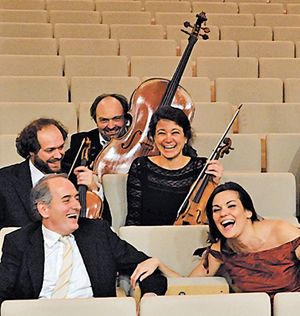Viva Italia!
The first performance of music band La Venexiana in Kyiv turns out a tremendous success
The concert “Captivated by Inspiration” took place at the Mykola Lysenko National Philharmonic Society Column Hall. The event was sponsored by the Embassy of Italy in Ukraine and the Italian Institute of Culture. The concert was dedicated to the 20th anniversary of establishing the diplomatic relations between the Italian Republic and Ukraine. It should be mentioned that lately our public started showing more interest in baroque art (suffice it to recall the recent unique exhibit at the National Art Museum), though Kyivites are not spoiled with music presentations. That is why the arrival of the famous band, conducted by Claudio Cavina and known as the “New Orpheus of the Italian madrigal repertoire” (The Day No. 61, October 16, 2012), was anticipated by Ukrainian music lovers. The concert program consisted of works by famous baroque composers, each of them being an innovator or reformer in the music art of their epoch. Thus, Claudio Monteverdi is considered to be the major baroque composer. He lived in an age of revolutionary changes, the transition from Renaissance to baroque, and he contributed to those changes: his opera L’Orfeo started the true history of this genre. Maestro Alessandro Scarlatti was the founder of the famous Neapolitan opera school (16th-17th centuries), which deeply influenced the young Handel. Francesco Cavalli, the founder of the bel canto opera genre, is also recognized as one of the most important composers of the 17th century, who developed the genre of opera. Alessandro Stradella laid foundations of the famous genre of instrumental concert, and George Handel is one of the titans of late baroque. So, a wide panorama of music works from early to late baroque was presented to the audience in Kyiv, which had an opportunity to hear authentic instruments of that age. In particular, the shape and the low-pitched, bass sound of the theorbo excited a lot of attention and curiosity in the audience. The instrument, which was played by Gabriele Palomba, used to have a counterpart in Ukrainian music after the 16th century. The Ukrainian version, the teorban, was also popularly known as the “lord’s bandura.” Nevertheless, it was La Venexiana’s brilliant soloist Roberta Mameli (soprano) that captured most of the audience’s attention.
Serhii KOTKO, the soloist of the National House of Organ and Chamber Music and laureate of numerous international contests, shared his impressions of La Venexiana’s performance. By the way, the greater part of Kotko’s repertoire is made up by works of the abovementioned composers. “You know, as I listened to this wonderful lady singer, the great Monteverdi’s words sprang to my mind: ‘Human language is the queen of harmony, not its servant.’ The singer’s mastery of her magic instrument, the voice, is unbelievably plastic and perfect. We heard the true instrumental vocal singing, almost devoid of vibratos, which is somewhat unusual for us – but this is exactly what baroque music requires, and Roberta Mameli was very convincing in her ‘star status,’ with her impeccable feeling of style, easy performance of the most complicated fioritures, elegant phrasing, and immersion in the emotional atmosphere of that distant epoch, when, after a millennium of neglect, human passions and emotions came into classic composers’ focus of attention.”
After the main program was over, the audience burst out with a storm of applause. The standing ovation lasted more than a quarter of an hour, and the Italian musicians, however tired, had nothing else to do but perform three more encores.






